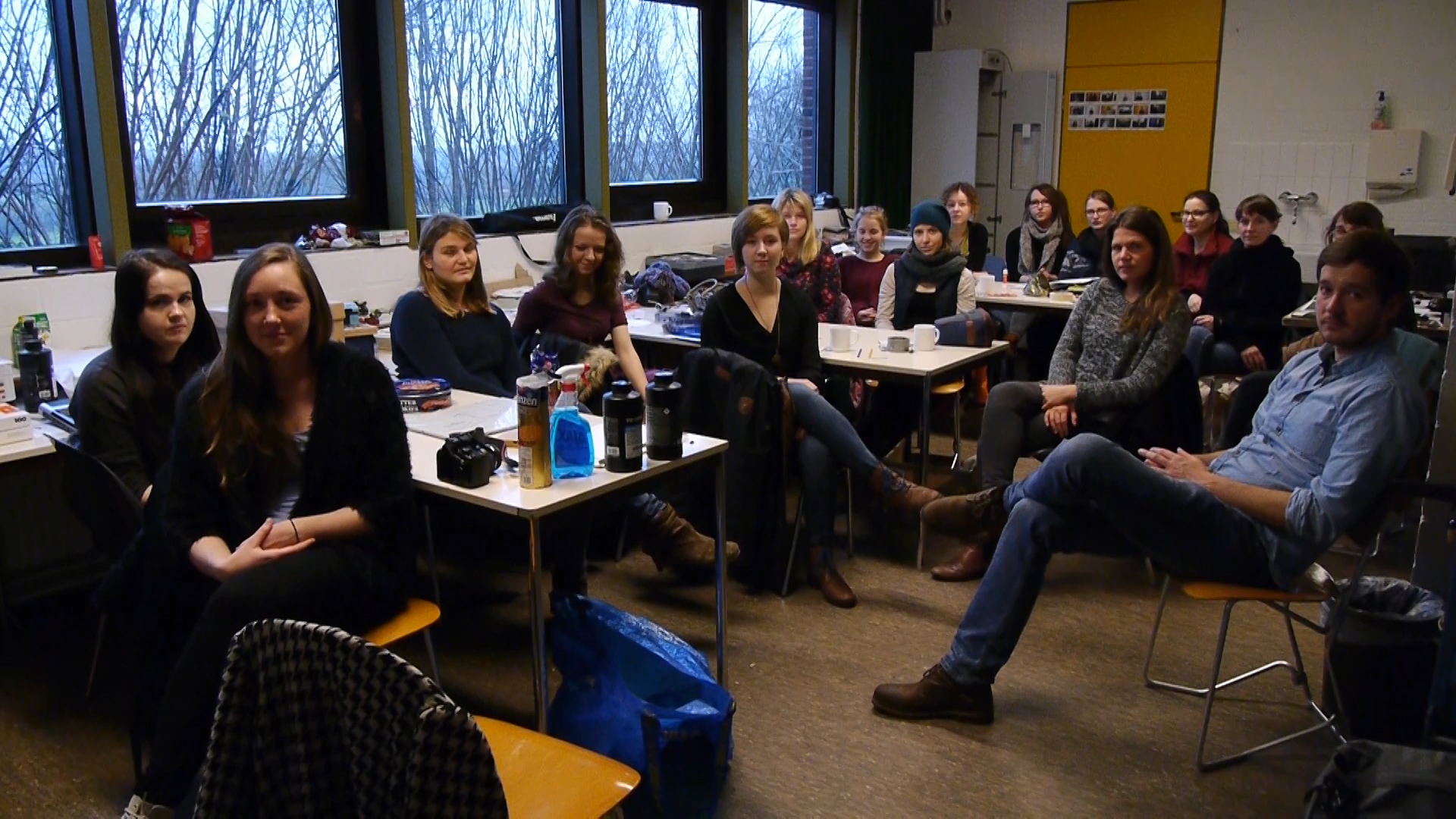
A PHP Error was encountered
Severity: Notice
Message: Undefined variable: galleryPhotos
Filename: subpages/work.php
Line Number: 64
Klasa / Class, 2015
video, loop
The work shows a group of students sitting in a photo lab and gazing at one point – straight into the camera lens and – in effect – at the viewer. Sixteen people gazing at them. Those people are moving slightly. Trees swaying in the wind are visible behind the window. Regardless of minuscule movements, the static situation lasts endlessly. Visual contact is permanent. Absence of straightforward occurrences results in the viewer looking at the work as if it were a painted image or a group photograph. They watch individual figures; they start searching for meaning in miniscule facial expressions or gestures. While watching, they become drawn into in a situation of an exchange of glances. Finally, they must make a decision to interrupt the eye contact.
The loop applied in this work results in the glance being prolonged, which in this manner turns into looking. While a glance assumes a brief inspection of a situation and precedes a possible further involvement, looking is full participation. The viewer feels that, in the contact with the people presented on the screen, they are being watched.
The endless situation builds up tension. The figures seem to be awaiting something which will happen. They are focused on the object, which eventually is the viewer, which puts the viewer in a situation where they, their activity is what the figures are waiting for.
Prolonged eye contact is something disturbing in contact with strangers. It is rather reserved for close relationships. Gazing makes the viewer pulled into the image, they stop being a passive observer of events on the screen. The work entangles them in a situation where they need to make a decision to stop it. The gaze directed at the viewer never ends.
//
Praca ukazuje grupę studentów siedzącą w pracowni fotograficznej i patrzącą w jeden punkt – wprost w obiektyw kamery, a w efekcie na widza. Szesnaście osób jest w niego wpatrzonych. Osoby te delikatnie się poruszają. Za oknem widać poruszane wiatrem drzewa. Statyczna, pomimo drobnych ruchów, sytuacja trwa w nieskończoność. Kontakt wzrokowy jest permanentny. Brak wyraźnych zdarzeń powoduje, że widz ogląda tę pracę, jakby była obrazem malarskim, czy grupową fotografią. Przygląda się pojedynczym postaciom; zaczyna doszukiwać się znaczenia w drobnej mimice czy gestach. Oglądając, zostaje wciągnięty w sytuację wymiany spojrzeń. Ostatecznie jednak to on musi podjąć decyzję o przerwaniu kontaktu wzrokowego.
Zastosowana w tej pracy pętla powoduje przedłużenie spojrzenia, które zamienia się w ten sposób w patrzenie. Podczas gdy spojrzenie zakłada szybki ogląd sytuacji i poprzedza ewentualne zaangażowanie się w nią, patrzenie jest już pełnym uczestnictwem. Widz czuje się, w kontakcie z przedstawionymi na ekranie osobami, obserwowany.
Niekończąca się sytuacja buduje napięcie. Postacie zdają się czekać na coś, co ma się wydarzyć. Wzrok mają skupiony na obiekcie, jakim ostatecznie jest widz, co stawia go w sytuacji, w której to on, jego działanie, jest tym, na co czekają.
Przedłużający się kontakt wzrokowy jest czymś niepokojącym w styczności z nieznanymi osobami. Zarezerwowany jest raczej dla bliskich relacji. Patrzenie powoduje, że widz zostaje wciągnięty do wnętrza obrazu, przestaje być biernym obserwatorem wydarzeń na ekranie. Praca wikła go w sytuację, o której zakończeniu sam musi zdecydować. Spojrzenie skierowane na niego nie ma bowiem końca.